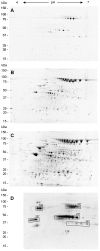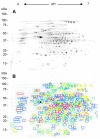Bacillus anthracis secretome time course under host-simulated conditions and identification of immunogenic proteins
- PMID: 17662140
- PMCID: PMC1949399
- DOI: 10.1186/1477-5956-5-11
Bacillus anthracis secretome time course under host-simulated conditions and identification of immunogenic proteins
Abstract
Background: The secretion time course of Bacillus anthracis strain RA3R (pXO1+/pXO2-) during early, mid, and late log phase were investigated under conditions that simulate those encountered in the host. All of the identified proteins were analyzed by different software algorithms to characterize their predicted mode of secretion and cellular localization. In addition, immunogenic proteins were identified using sera from humans with cutaneous anthrax.
Results: A total of 275 extracellular proteins were identified by a combination of LC MS/MS and MALDI-TOF MS. All of the identified proteins were analyzed by SignalP, SecretomeP, PSORT, LipoP, TMHMM, and PROSITE to characterize their predicted mode of secretion, cellular localization, and protein domains. Fifty-three proteins were predicted by SignalP to harbor the cleavable N-terminal signal peptides and were therefore secreted via the classical Sec pathway. Twenty-three proteins were predicted by SecretomeP for secretion by the alternative Sec pathway characterized by the lack of typical export signal. In contrast to SignalP and SecretomeP predictions, PSORT predicted 171 extracellular proteins, 7 cell wall-associated proteins, and 6 cytoplasmic proteins. Moreover, 51 proteins were predicted by LipoP to contain putative Sec signal peptides (38 have SpI sites), lipoprotein signal peptides (13 have SpII sites), and N-terminal membrane helices (9 have transmembrane helices). The TMHMM algorithm predicted 25 membrane-associated proteins with one to ten transmembrane helices. Immunogenic proteins were also identified using sera from patients who have recovered from anthrax. The charge variants (83 and 63 kDa) of protective antigen (PA) were the most immunodominant secreted antigens, followed by charge variants of enolase and transketolase.
Conclusion: This is the first description of the time course of protein secretion for the pathogen Bacillus anthracis. Time course studies of protein secretion and accumulation may be relevant in elucidation of the progression of pathogenicity, identification of therapeutics and diagnostic markers, and vaccine development. This study also adds to the continuously growing list of identified Bacillus anthracis secretome proteins.
Figures







References
LinkOut - more resources
Full Text Sources
Other Literature Sources

